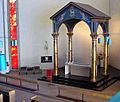Altar facts for kids
An altar is a special place, often like a table, where religious ceremonies and events happen. People use altars in many different religions around the world, including Christianity, Hinduism, and Buddhism. It's a central spot for worship, prayers, and offerings.
Contents
What is an Altar?
An altar is a very old and important part of many religions. It's a dedicated spot where people connect with their God or gods. Sometimes, an altar is a simple table. Other times, it can be a large, decorated structure or even a natural rock.
People use altars for many reasons:
- To offer prayers and show respect.
- To place special items like candles, flowers, or food.
- To perform religious rituals or ceremonies.
Altars are seen as sacred places. They help people feel closer to their faith and traditions.
Altars in Different Religions
Altars look different and are used in various ways depending on the religion.
Christian Altars
In Christianity, altars are usually found in churches. They are often the most important part of the church building.
- Purpose: The main use of a Christian altar is for the Eucharist, also known as Communion. This is a special service where Christians remember the last supper of Jesus Christ.
- Appearance: Christian altars can be simple wooden tables or grand stone structures. Many are decorated with cloths, candles, and crosses.
- Types: Some churches have a "high altar" at the very front. Others have a "free-standing" altar that people can walk around.
Hindu Altars
In Hinduism, altars are very common, both in temples and in homes.
- Purpose: Hindu altars are used for puja, which is a form of worship. People offer prayers, light incense, and present food or flowers to their gods.
- Appearance: Home altars can be small shelves or dedicated rooms. They often have statues or pictures of gods and goddesses.
- Offerings: Devotees place fresh flowers, fruits, sweets, and light lamps or candles as offerings.
Buddhist Altars
Buddhism also uses altars in temples and homes.
- Purpose: Buddhist altars are places for meditation, offerings, and showing respect to the Buddha and other enlightened beings.
- Appearance: They often feature a statue or image of the Buddha. You might also see candles, incense, flowers, and bowls of water or food.
- Practice: People bow, chant, and make offerings to gain merit and focus their minds.
Shinto Altars
In Japan's Shinto religion, altars are called Kamidana.
- Purpose: A Kamidana is a small household altar. It's used to worship kami, which are spirits or deities in Shinto.
- Appearance: They are usually small wooden shrines. They often contain a small mirror, sacred objects, and offerings like rice, salt, and water.
- Location: Kamidana are placed high up in a home or business.
Ancient Altars
Altars have been used for thousands of years by ancient civilizations.
- Purpose: In ancient Greece and Rome, altars were used for sacrifices to the gods. This often involved offering animals or food.
- Appearance: These altars could be simple stone blocks or large, elaborate structures in public spaces.
- Examples: Famous ancient altars include the Pergamon Altar, which was a huge structure dedicated to Zeus.
Related pages
Images for kids
-
A home altar in a Methodist Christian household, with a cross and candles surrounded by other religious items
-
High altar of Saint Peter's Basilica, Rome
-
Altar at the Lutheran Jesus Church in Valby, Copenhagen.
-
The Lutheran altar in Bad Doberan Minster
-
A traditional Russian Orthodox Holy Table (Altar), Church of the Saviour on the Blood, St. Petersburg
-
The Holy Place (Sanctuary) in the church of the Saint Vladimir Skete at Valaam Monastery. To the left is the Holy Table (altar) with the Gospel Book, the Tabernacle, and the seven-branch candlestand. The Table of Oblation is in the background to the left. To the right is the Cathedra (Bishop's Throne).
-
A contemporary Byzantine Catholic altar during the Divine Liturgy at St. Joseph Church in Chicago, Illinois.
-
Murugan temple in Roermond, Netherlands.
-
Detail of c. 1700 painting of a Taoist altar during a ritual for the dead, illustrating a scene from The Plum in the Golden Vase. Note the Three Purities plaques at the back of the altar, and the ritual implements, including incense burner and ritual sword on the right. Bowls hold food offerings for the deceased woman.
-
A bàn thờ (worship table) is an altar used in ancestral worship and worship of Buddhas and gods in Vietnam
-
Horned altar at Tel Be'er Sheva, Israel.
-
Ancient Greek kylix showing a hoplite offering a sacrifice before an altar, around 480 BC. Ancient Agora Museum of Athens in the Stoa of Attalus
-
The altar with ciborium at All Saints Anglican church, Bristol, England
-
Altar at Grace Cathedral, San Francisco
See also
 In Spanish: Altar para niños
In Spanish: Altar para niños






































